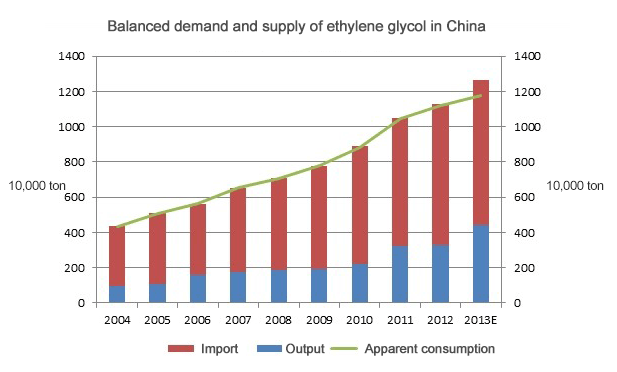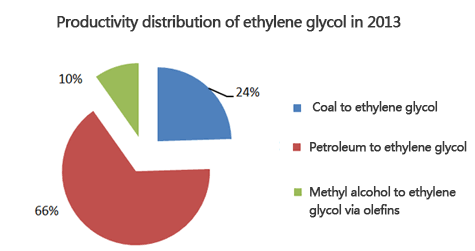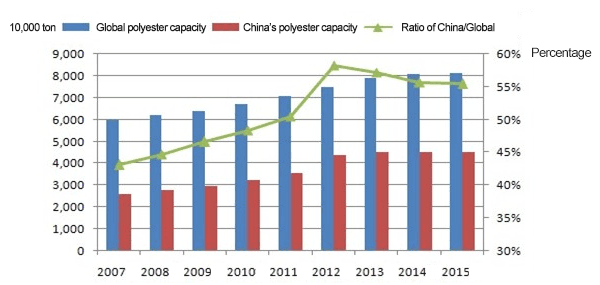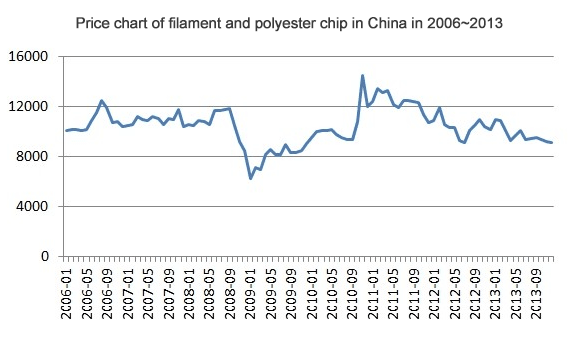In recent years, driven by the rapid growth of the domestic polyester industry, the consumption of ethylene glycol increases rapidly. The apparent consumption of ethylene glycol was 24 million tons in 2001, and it reached more than 100 million tons in 2011, the annual compound growth rate is approximately 14.6%. In 2012, the apparent consumption of ethylene glycol increased to 11.6 million tons, and the export amount is 7.94 million tons, however, the self-sufficiency rate is only 31.3%.
Though China's ethylene glycol production capacity and output has increased significantly in recent years, the gap between supply and demand still remains high. It is expected that the consumption of ethylene glycol in 2013 will reach 12.35 million tons, of which 8.59 million tons will be imported. Under the influence of shortage in oil resources, high oil prices, insufficient capacity of ethane gas in Middle East, and the rapid development of polyester industry, the downstream enterprises all wish to benefit from the development of SEG® technology.

Due to serious shortage, ethylene glycol always keeps at high prices in China. The average price in the recent 7 years is 8157.4 Yuan/ton. According to recent reports, it is predicted that ethylene glycol will become one of the star products that lead the development of global chemical industry. The overhaul plans of relevant manufacturers show that there will be tight supply of ethylene glycol in Asia in 2014.
In the third and fourth quarters of 2014, two ethylene glycol plants in Jubail, Saudi Arabia will conduct overhaul and replace the reactors, which will take two to three months. The designed output capacity of the two plants is 1.34 million tons a year. Eight other plants in Thimphu and Jubail will also conduct equipment maintenance in turn in 2014, the maintenance for each plant will take about two weeks. The total output capacity of the 8 plants is 4.37 million tons a year.
Sinopec Zhenhai Refining & Chemical will also conduct equipment maintenance for a month in the second quarter for its 650,000 ton glycol plant. Many upperstream olefin plants in Japan will conduct maintenance in 2014, which will affect the production of 4~5 glycol production plants, and the glycol output in Japan will reduce by 6~7 tons. Meanwhile, there are only a few newly built glycol plants in Asia in 2014. It is predicted that there will be tight supply of glycol supply in Asia in the latter half of 2014. By that time, the price of glycol via naphtha will rise sharply and the price of SEG® glycol will keep certain margin with the price of glycol via naphtha.

In recent years, the production capacity of domestic coal-to-ethylene glycol continues to expand. According to the preliminary statistics conducted by Beijing Booming HighChem Technology Co., Ltd. As of 2013, China's ethylene glycol production capacity has reached 5.1 million tons, among which, the CTEG production capacity has expanded from 200,000 tons in 2012 to 1.25 million tons in 2013. However, the output is less than 200,000 tons. The average monthly load of Xinjiang Tianye exceeds 80%.



